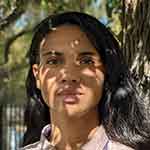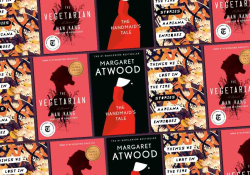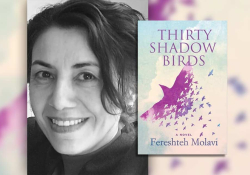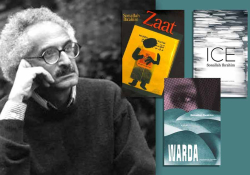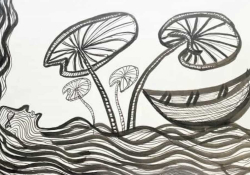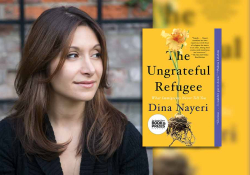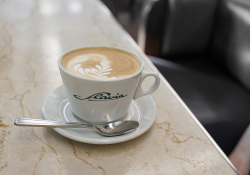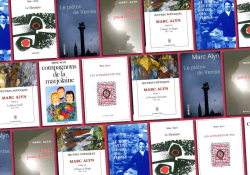GOD-IS | Collage in Motion
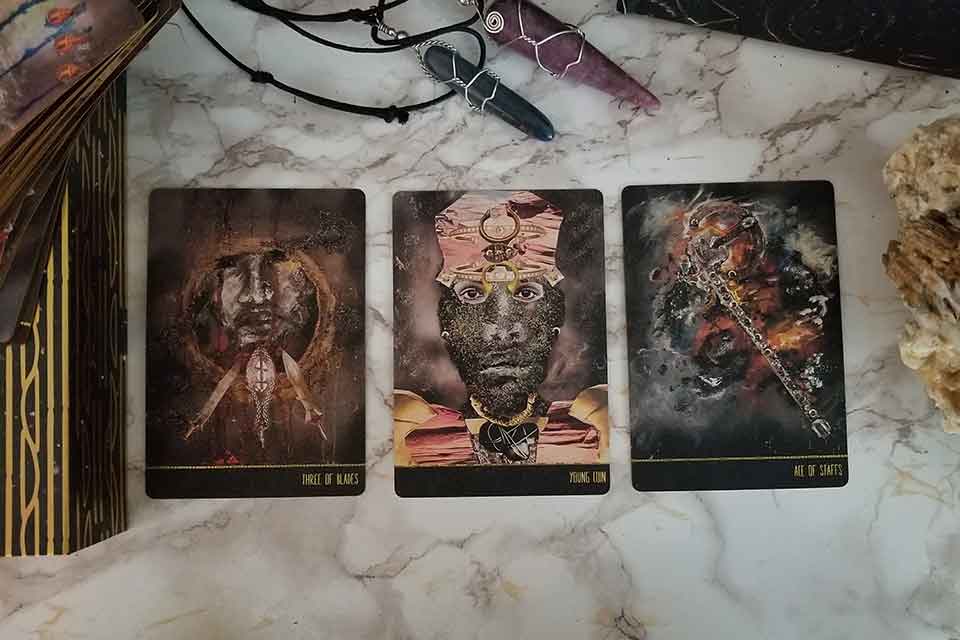
How do images shape us culturally and allow us to articulate ourselves culturally? A writer considers what performance and collage have in common and how, as Tina Campt would put it, an influential cohort of Black artists is pointing viewers toward “new ways of encountering the precarity of Black life.”
GOD-IS is not yet complete. On June 21, artist Courtney Alexander shared that she was with Mayra Cortez at Franconia Sculpture Park via Facebook Live: What is not shown here is the hours of footage Mayra Cortez and I took throughout the park and other areas. I took a lot of time in this ritual over a few days, leaving offering for the land. Prayer. Dancing. And meditation. All of this will be compiled into a short film and series of photos.
In anticipation of the full film, Alexander dropped short videos of herself adorned in dark robes, white filmy fabric, and long dreadlocks, smoke and chants billowing from her mouth. She describes this costume as
a covering that embodies my timelessness. The crown is made of trash bags and hair, with brass metal shells that reminded me of bullet casings. As a person who has lived with intense anxiety around death, this work has also helped me embrace my own sense of (im)mortality as well. At this altar I am a living god with all my complexities and contradictions.
In one clip, a sunbeam slices through the video and we hear birdsong as we see a white woman with cropped blonde hair sitting in a vertically upturned white bathtub. As she stands, we can see flowers and a note in her hands, and she walks forward on a paved path to a much larger bathtub where Alexander as deity figure is seated, her nearly black shape taking up almost half of the cavernous white tub. We cannot hear the words exchanged, but the woman leaves her offering and bows before walking off to join other onlookers on the sunny lawn.
The performance takes place within Alone Together, a 2019 installation by Emmet Ramstad, which combines rebar, mortar, stucco, wood, paint, bathtubs, earth, grass, and concrete, mixing “the vulnerability of the bathtub, a place of solitude, cleansing and reflection, with connection across a divide.” Alexander noted her intention to “transform Emmet Ramstad’s installation Alone Together into reflective altars for myself and the audience” and how she found “their work beautifully fitting in the way . . . [their] intentions . . . overlap.”
Experiencing Alexander’s work an Atlantic Ocean away, the internet has functioned as that concrete path for me, rolling me toward her creations and allowing me to connect across the divide. While we have never met in person, I first encountered her art through Dust II Onyx: A Melanated Tarot and interviewed her for the Asymptote Journal translation podcast in 2017, the year her deck was released.
I recently pulled the Ten of Blades in Courtney’s deck (awakened: karmic lessons, silver linings, endings, rebirth, the worst is over; dormant: death, distress, hitting rock bottom, pain, and desolation). The collaged painting mixes oil paint, acrylic, pastel, sand, microbeads, glitter, rhinestones, spray paint, and magazine clippings on Dura-Lar. For the Ten of Blades, she uses a picture of the
enslaved African man named Gordon, also known as “Whipped Peter” [who] escaped from the plantation where he was enslaved, traveled by foot for ten days and gained freedom once he reached the union camp in Baton Rouge, Louisiana. . . . Photos of the brutal scars he received from beatings circulated through Harper’s Weekly [and] shed light on the inhumane treatment those who’d been enslaved were subjected to. Gordon’s image is not only a testament to the horrors of slavery, but also to the dignity and poise he maintained, despite what he endured.
Black people are praised for maintaining poise and dignity in impossible situations. Alexander notes that much of her work “has focused on understanding how [she navigates] the world as a fat Black femme—the ways [she takes] up space, the ways [she’s] expected to contort [herself] physically and energetically, the language [her] body holds and how it has morphed with [her] personal growth. Over time [she has] sought ways to live beyond its perceived limitations.”
Black people are praised for maintaining poise and dignity in impossible situations.
In “A Black Gaze: Artists Changing How We See: Tina Campt in Conversation with Ra Malika Imhotep,” Campt reads a passage from A Black Gaze exploring “the endless archive of found footage” available online in relation to Jay-Z’s 2017 “4:44” music video, which was directed by the artist Arthur Jafa. She explains how it whiplashes us between images of joy and pain, and it is precisely this whiplashing that strikes a chord in Dust II Onyx. Similar to the cover of A Black Gaze (a still from Arthur Jafa’s film Crystal and Nick Siegfried), the figures in Dust II Onyx are dark on a dark background: black on black, inviting us to look closely and find those borders that reveal celestial bodies. Campt speaks of the challenge of lighting dark on dark and how it brings out the subtlety of all those gradations of blackness, calling up “what is sacred in the distance between each of us.”
Alexander’s whiplashing collage in Dust II Onyx marries Maya Angelou’s eyes with a face inspired by Michelle Obama; the eyes of Nicki Minaj are placed in conversation with the facial features of Solange Knowles; Tiq Milan sits in conversation with James Brown; and the eyes of Tupac Shakur and Nikki Giovanni look out of faces painted in homage to Missy Elliott—Duke Ellington, Prince, Jaden Smith, the eyes of young Michael Jackson, Laverne Cox, Sojourner Truth, Neil deGrasse Tyson, and George Washington Carver. Though we speak of the eyes as windows, it’s hard to recognize a person from their eyes alone, and this work invites us to explore what makes these slivers of characteristics so iconic. How much of someone do we need?
Alexander’s whiplashing collage in Dust II Onyx marries Maya Angelou’s eyes with a face inspired by Michelle Obama.
And what does collage have in common with performance? Both contain unpredictability and chance. They require intuition and being spirit-led. Alexander noted that by
converting the spaces into altars, the audience was able to enter their personal sacred space in the smaller tub and sit in reflection of my own altar. Being in a space of mutual sacredness and honoring. Because of the way the tubs were designed the audience could also speak very quietly, and I was still able to hear them across the divide while those on the outside could not.
Just as there is chance involved with what might be found available for collage, performance in which an unknown audience participates makes use of the unexpected. In Amy Kilgard’s “Collage: A Paradigm for Performance Studies” (2009), she explores how these two forms might be understood juxtapositionally:
Doubleness functions in several distinct ways in thinking about performances as collage. For example, components of performances often have distinct lives outside of the performances. When we use these elements as props, costumes, movement sequences, or texts, they each bear traces of their previous worlds in the performance. Each performance choice we make for a staged work carries with it its history in a world or worlds outside the performance. And we, as critics and audience members, carry our histories with these choices/fragments into the performance, too.
Can performance in another artist’s installation be understood as collage? Alexander expanded upon how forced uncertainty and improvisation of performance allow her Virgo brain to break out of control and perfectionism. She likened performance to working with clay, explaining that this kind of collage was akin to 2D molding, how when you go into a space that you don’t create, a performance is never the same twice, just as a collage with found materials might never be replicable.
GOD-IS at the Franconia Sculpture Park was the second performance of the piece; the first took place at the National Arts Club in New York. For Alexander, placing herself in the context of deity was a complex decision, as using herself as her own collage material brought to light and foregrounded those “previous worlds” her body was and is a part of; “it is not lost on [her] that the way [she experiences] this in a heavily politicized body will still affect the way this piece is experienced and how it is read.” Alexander is an artist with deep pockets:
I’ve been on a journey from the opaqueness of my identity shaped by my history and the history of my communities to one of translucency where a new world held and ruled by my own hands can now shine through. Where do I pull freedom from in a world that never wants to see me free? How do I experience the magic of my existence? How do these multiple realities and timelines intertwine into what makes up who I am?
To extend those questions into Campt’s lexicon: How do images shape us culturally and allow us to articulate ourselves culturally? Understanding performance as collage allows us to locate Alexander within what Campt calls “this growing and increasingly influential cohort of Black artists choosing to look after, care for, and reclaim an uncomfortable Black visual archive that makes audiences work through and toward new ways of encountering the precarity of Black life.”
Alicante, Spain
Editorial note: Layla Benitez-James’s essay on André Leon Talley appears in the May 2022 issue’s special section, “Muses.”
